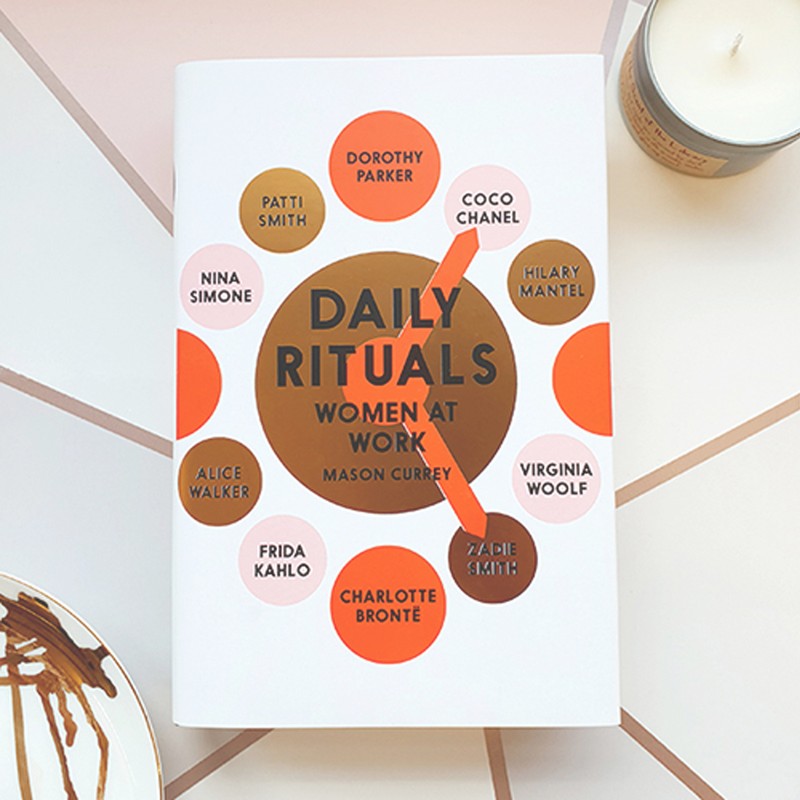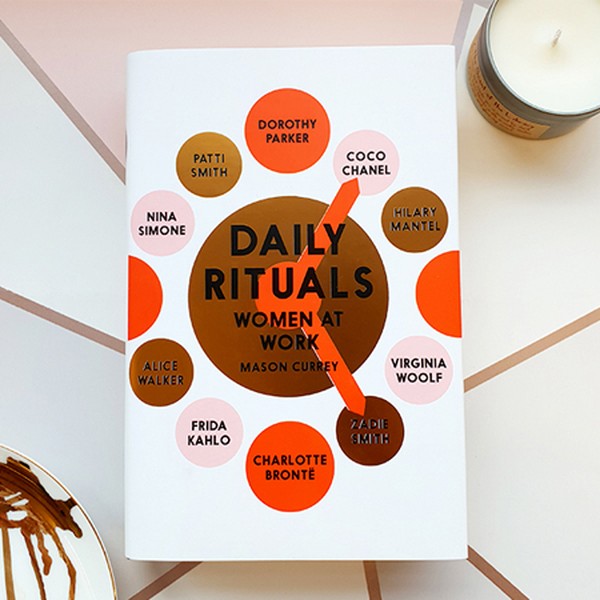Daily Rituals: Women At Work By Mason Currey
Author Mason Currey calls Daily Rituals: Women at Work both “a sequel and a corrective”. His first book, Daily Rituals: How Great Minds Make Time, Find Inspiration, and Get to Work was a collection of profiles, much like this one, that looked at the day-to-day lives of creatives, from writers to poets, painters to composers. They ranged from the obsessive – Beethoven counted out 60 coffee beans for his morning brew – to the downright weird – novelist John Cheever would put on his suit, leave his apartment, and head down to his building’s basement, before stripping to his boxers to write. But there was an issue with this book that Currey was keen to acknowledge: out of the 161 profiles featured only 27 of them were women. “How could I have let the book go to press with such a glaring gender imbalance?... That I didn’t work harder to find more women’s stories to tell shows a dismal lack of imagination on my part, and is something I sincerely regret.”
It takes guts to acknowledge such failings in the opening of his second book, but what follows is a genuine and sincere effort to make amends, focusing instead on 143 female artists, which “opens dramatic new vistas of frustration and compromise.”
While few of these women were raised in wealthy families, the majority grew up in societies “that ignored or rejected women’s creative work, and many had parents or spouses who vigorously opposed their attempts to prioritize self-expression over the traditional roles of wife, mother, homemaker.”
It’s true – many of the women featured struggled with such things – facing the indignation of history’s gender stereotypes and oppressive spouses. Novelist and poet Penelope Fitzgerald lived with an alcoholic husband and three children, working as a school teacher to support the whole family. As such, she didn’t publish anything until she was 58. Clara Schumann, accomplished virtuoso pianist, was left to care for her eight children because her composer husband Robert, thought she should prioritise household chores over her piano practice.
This book serves as perfect proof of how much harder women work to succeed, and how they do it with grace. Even the decadent life of Coco Chanel started in poverty as she spent her adolescence in an orphanage, but work became her life and, as Currey says “the only truly reliable partner she ever found.”
The women all sought different ways to be productive. Punk singer Patti Smith prefers getting creative under the covers: “I have a fine desk but I prefer to work from my bed.” French painter Romaine Brooks was adamant it was “essential to live alone,” whereas author Eudora Welty claimed she could write anywhere. For others, it’s a reliance on vices that allowed them to create – after a streetcar accident, it was constant doses of Demerol (opioid pain medication) that enabled Frida Kahlo to carry on painting.
What this lovely book shows is there’s no single way to work and there’s no single way to be successful. Time doesn’t make these women any less relatable – we all recognise the inclination to work hard despite life’s difficulties. This book pays more attention to family dynamics than its predecessor, because Currey acknowledges for many women, children were “the other major competing demand on their time”. Not all of them are perfect – some chose simply to neglect certain pressing duties – but it shows women on a vast and glorious spectrum, whose desires to be creative were fierce and unapologetic.

SL Chats To Mason Currey
My goal with both Daily Rituals books was to show how a variety of creative people actually got down to work… From novelists to poets to painters to composers. Because if you’ve ever tried to pursue a long-term creative project, you may have noticed – it’s hard. In my experience, the state of mind required is a fleeting, fragile thing. And there are many ways to get derailed. Looking at the routines and rituals of great creative minds gives you ideas for how to approach it. And they’re just fascinating in their own right.
This book taught me that everyone struggles with creativity sometimes… I’ve always found writing quite painstaking. Even in the best of circumstances, it’s a gradual, halting process for me, with the constant temptation to take a break and do something else. It takes a lot of willpower to stay at the desk and stick with it. What the books have taught me is that I’m not alone. It’s comforting that brilliant minds have struggled with their work in similar ways. While working on a novel, the writer Elizabeth Bowen noted in her journal: “From rubbing my forehead I have worn an enormous hole in it, which bleeds.” That sounds about right to me…
I hope people find some habits or behaviours that resonate with their own lives… I don’t intend the books to be prescriptive—when it comes to making a career as an artist, there’s no single way to do it. It’s useful to read how other people have done it. The writer Doris Lessing said these kinds of questions “are a fumbling instinct towards this crucial point, which is: how do you use your energy?” Lessing went on to note, we have limited amounts of energy, and have to figure out how to use it most effectively. Reading about these figures’ daily lives, gives a sense of how they did it, or at least that was my aim.
The new book took about two and a half years to research and write… My research method was to pull out library books on noteworthy creative women and skim-read them for interesting details about their daily work lives. I paid particular attention to published diaries, letters and interviews, because I wanted to let my subjects speak for themselves. Anything interesting I copied and put into a folder. I ended up with hundreds of these folders – some stuffed with interesting material, some containing a few titbits. Then I synthesized the material into readable mini-biographies of these women’s working days. I also sent out interview requests to contemporary women writers, artists, and performers and I spoke to 20 of them for the book.
These women were ground-breaking in their fields… The first Daily Rituals book disproportionately featured men. In the years since that book came out the gender imbalance felt more and more egregious. So, with this second volume I included only women as a way to correct that. I didn’t specifically set out to feature lesser-known women—in fact, pretty much all of the women in the new book were major. But because women in the arts have historically been stymied and marginalized, their achievements are less well known. I hope this book will introduce readers to some amazing work they may have missed.
If I were to pick one person in the book, I wish I was like Vanessa Bell… She was Virginia Woolf’s older sister, and a gifted painter, illustrator, book-cover designer and interior decorator. But she also had a gift for living creatively – for making her life a kind of creative project, and surrounding herself with brilliant people. Her family’s country estate, Charleston, was the physical embodiment of this. As one visitor recalled, “Charleston in its heyday [was] an enchanted place—a place of such potent individuality that whenever I stayed there I came away grateful to it….for giving me so much pleasure, so many rich and varied visual sensations, such talk, such an awareness that lives were being intensely and purposefully led there.” I wish I had that gift for vitality.
Playwright Lillian Hellman’s ritual shocked me the most… In the 1940s, she told a reporter that she was drinking 20 cups of coffee and smoking five packs of cigarettes a day. If that’s true, I’m shocked she lived to be 79.
The writer Maggie Nelson inspired me the most… Before we spoke, she warned me she would probably be “a dull subject,” because she doesn’t follow a daily writing routine. She told me she’s more of a “project-oriented person,” and when she’s in a project she writes constantly and feverishly. But when she’s not in a project she doesn’t force herself to write; as she put it, “there’s no point in going to the computer and pecking away.” That’s an attitude I would like to emulate. When I’m not in the midst of a writing project I think I need to discipline myself and spend many hours per day writing – but maybe I just need to relax. This comes up again and again in this material—the tension between forcing it, but not forcing it too much. So many artists have spoken about the folly of waiting for inspiration to strike, the importance of working regularly whether you feel like it or not. But there’s also a need to step away from your work and recharge. I’m always trying to figure how to strike that balance in my daily life.
I start my own daily routine at 5.30am… I’m a die-hard morning person – I’ve always enjoyed a special kind of focus early in the morning. Unfortunately, this feeling fades as the sun rises. So, weekdays I get up early and try to seize that window of opportunity. I’m always resolving I won’t check email or look at my phone for the first hour or two of the day. I can’t say I succeed in this very often.
I think people’s rituals are open for interpretation… Which is part of the fun. Reading about someone’s daily rituals, you quickly get a sense of their personality and priorities in life. For instance, Kate Chopin never wrote on any kind of timetable, and didn’t keep a separate writing room – according to her daughter, she preferred to write with her six children “swarming about her.” By contrast, the choreographer Martha Graham avoided social engagements in order to spend more hours alone in her studio. “Talk is a privilege and one must deny oneself that privilege,” she said. Reading these kinds of detail, I feel I understand these women and their work a little better.
Daily Rituals: Women at Work by Mason Currey is available now
DISCLAIMER: We endeavour to always credit the correct original source of every image we use. If you think a credit may be incorrect, please contact us at info@sheerluxe.com.



